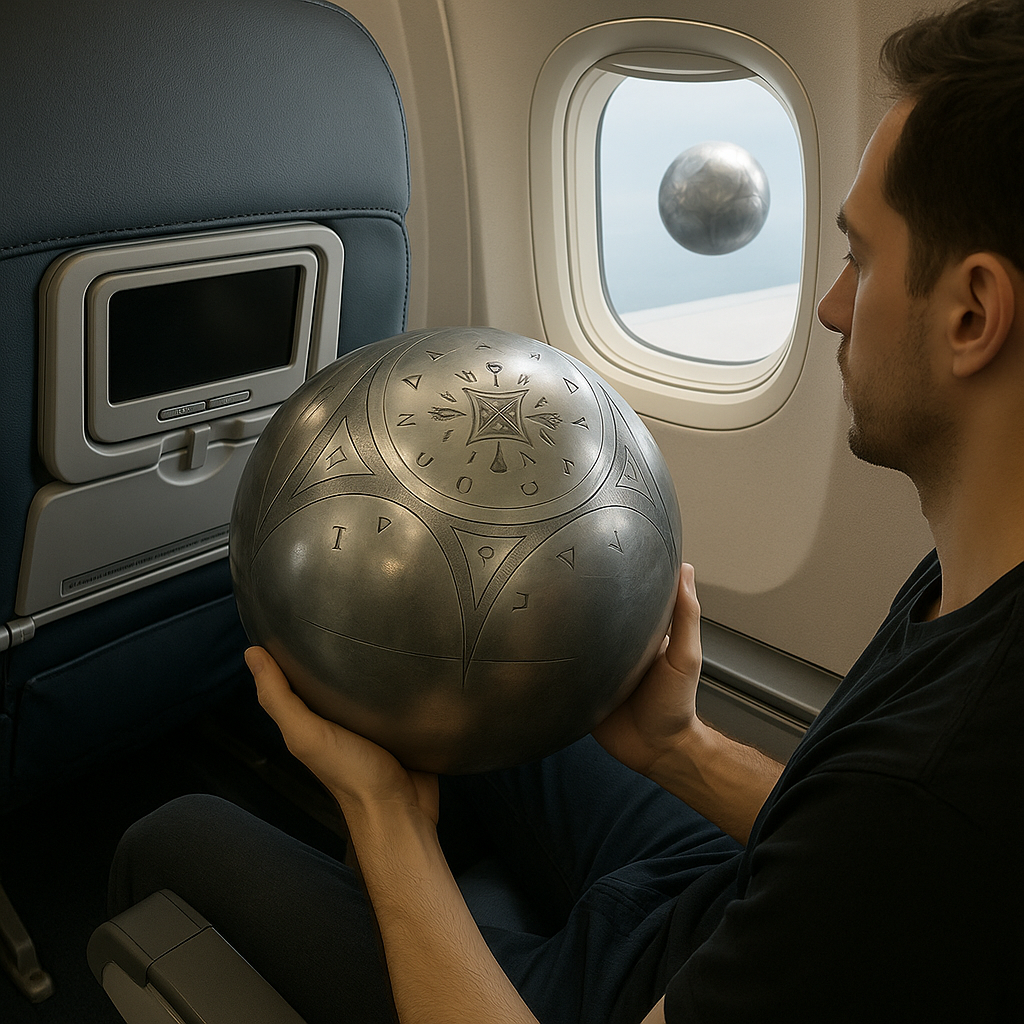Thought Experiment: Would the FAA Allow the Buga UFO Sphere on a Commercial Airliner?

Imagine boarding a flight at Newark Liberty, and as you shuffle down the aisle looking for your seat, you spot a passenger clutching a polished, metallic sphere the size of a beach ball. Not just any sphere—this one’s etched with strange markings, reflecting the cabin lights with an almost organic shimmer. You recognize it from social media and the whispers floating around New Jersey: the so-called “Buga UFO Sphere.”
Now here’s the million-dollar question—would the FAA, or any other three-letter agency with a vested interest in UFOs, really allow this thing on board?
To explore that, let’s assume the FAA is fully briefed. That they’ve been looped in on the 2024 UFO sightings over New Jersey, where orbs were tracked on radar, observed by commercial pilots, and even involved in near-airspace shutdowns. These weren’t paper lanterns or weather balloons. These were controlled, maneuverable, and, according to some reports, responded to radio frequency spikes and radar locks.
And let’s not forget the UFO chaos of 2023. Over just nine days in February, four unidentified aerial objects were detected and shot down across North America—over Alaska, the Yukon, Lake Huron, and, most famously, the Chinese surveillance balloon off the coast of South Carolina. While the first was acknowledged as a spy balloon, the other three remain unexplained. The Alaskan object, silver and cylindrical, was tracked at 40,000 feet before being downed by an F-22 over the Beaufort Sea—never recovered. The Yukon object vanished into deep snow after another F-22 strike. And the Lake Huron incident? That was an octagonal craft with dangling strings, flying at 20,000 feet and taken out by a Minnesota Air National Guard F-16. All three recovery missions were abandoned due to weather, terrain, and perhaps more quietly, because no one really wanted to talk about what they found—or didn’t.
If the FAA has even a sliver of intelligence suggesting that these orbs—or objects like them—are capable of interacting with avionics, navigation systems, or the electromagnetic signature of a commercial jet, then no, there’s no way in hell they’d let that sphere board a plane.
But here’s where it gets weirder.
To the untrained eye, it could pass for a sculpture. If TSA scanned it, cleared it as non-explosive, and waved it through, it might seem harmless. But that illusion falls apart fast—there are multiple videos of it in flight, and it closely resembles other UFO spheres that have been recorded and photographed performing aerial maneuvers no known craft can replicate.
And now you’ve got a potential non-human artifact—possibly intelligent, perhaps even dangerous—sitting silently in a crowded cabin, surrounded by passengers unaware of what it truly is.
In the spirit of scientific reasoning, consider this an informal experiment. It functions as a kind of field test—where observation of institutional and public behavior becomes the dependent measure of belief in the sphere’s true nature.
The null hypothesis: The Buga UFO Sphere is inert, terrestrial in origin, and poses no greater risk or significance than any other unusual cargo item.
The alternative hypothesis: The sphere is non-terrestrial or exotic in nature, potentially autonomous or reactive, and its presence aboard a commercial airliner presents measurable risk—and possibly confirms non-human intelligence or unknown advanced technology.
Would anyone even get on that flight? If the Buga Sphere were openly brought aboard, passengers would face their own decision point. This wouldn’t just test government policy—it would reveal public belief. If the cabin fills up anyway, perhaps most people still assume it’s harmless. But if the sight of the object causes walk-offs, flight cancellations, or social media panic, that would signal something deeper: the public doesn’t just suspect these spheres are real—they fear what they might do. In that way, the boarding gate becomes a referendum on belief in non-human intelligence.
Let’s stretch that scenario. What if the sphere responds to altitude changes? What if it begins to emit radio frequencies or interacts with the plane’s autopilot system? And what if it’s not alone? These spheres are often seen in coordinated groups of three or four, forming what some have dubbed an AI-driven sphere network. So what happens if the one inside the plane begins to communicate or sync with others outside—hovering nearby, seen or unseen by passengers, but locked in some kind of data-sharing or surveillance formation?
In that case, you’ve essentially introduced a black-box intelligence device into a sealed metal tube with 200 human lives and one flight path. The FAA, already cautious with lithium-ion batteries, would melt down if they had even 10% certainty this object wasn’t inert.
And remember—New Jersey wasn’t a one-off.
Descriptions of the Buga Sphere match many of those reports: featureless silver, geometric engraving, and what private labs later described as non-terrestrial metallurgy. It’s not a stretch to believe the FAA has a classified file marked “Do Not Distribute” sitting in some secured cabinet.
And there’s more. Spheres like these have long shown a strange obsession with airliners. Pilot reports going back decades detail metallic spheres circling aircraft mid-flight. They hold distance, mirror turns, and then vanish at velocities no known drone can match. Some even appear to respond to cockpit behavior—turns, altitude changes, even radio chatter.
These aren’t rare. Pilots across the globe have described objects keeping pace with commercial jets, rising vertically through clouds, or hovering nearby before blinking out. Ground radar often misses them or catches a brief, unexplained anomaly. The FAA, NORAD, and private aviation firms all know. They just don’t publicly acknowledge it.
And it gets more unsettling. A specific pattern has emerged—UFO orbital behavior. These spheres don’t just trail planes; they orbit them. Several pilots have described that eerie sensation of being encircled mid-air by a glowing object moving with uncanny precision. That level of control suggests either adaptive AI or an intelligence far beyond human tech.
Then come the near misses. These aren’t stories of distant lights—they’re confirmed close encounters. Pilots have filed reports about metallic spheres flying just meters from the cockpit or fuselage. One glowing orb streaked past a commercial airliner with what the pilot called “uncomfortable proximity.” Another feared impact with the tail section before the object suddenly veered off.
If the FAA knows what we think they know, no way would this sphere fly commercial.
And it’s not a stretch to believe they do know more than they’re letting on. One of the clearest examples? So-called “pirate aircraft”—unmarked craft flying U.S. airspace with FAA authorization, allegedly for research and retrieval missions tied to UAPs. These craft often operate outside standard air traffic rules.
Trump knew, too.
What’s more, this moment—this decision to either allow boarding or seize the object—is the ultimate test. If the FAA truly believes, as their files and actions suggest, that UFOs are real and exotic in nature, then permitting the Buga Sphere on a passenger plane would be an unprecedented gamble. Either they confiscate it as classified material, or they risk endangering an entire commercial aircraft with something potentially volatile. Even a single sphere moving at hypersonic speed has the destructive capacity of a nuclear missile. A one-meter object traveling just under Mach 5 would carry enough kinetic energy to obliterate an aircraft, breach hardened targets, or even cause localized devastation on the ground. That’s without factoring in potential unknown energy signatures or reactive fields that haven’t yet been quantified.
This isn’t just about safety protocol. It’s a confrontation with reality. If the sphere is allowed to fly coach, that’s either willful ignorance—or confirmation that someone, somewhere, already knows exactly what it is and what it’s capable of.

